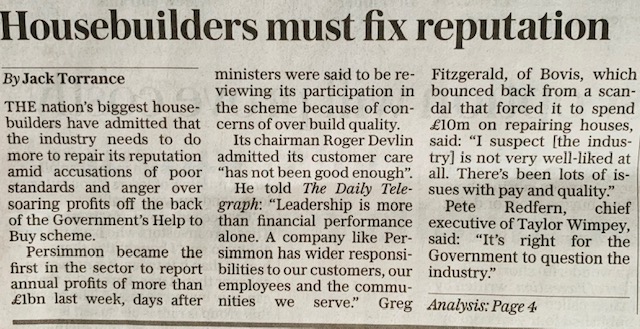Copied from Sunday Telegraph Sunday 16 April 2017
Economic Agenda
The key to opening up the housing market
By Liam Halligan
For decades across much of the UK far too few homes have been built. The average house now costs almost eight times annual earnings – an all-time record. In London and the South East, of course, this ratio is even higher.
Much of “generation rent” is simply unable to buy a home. For millions of youngsters, even those with professional qualifications and good jobs, property ownership is an ever more distant dream. Ten years ago, 64pc of 25 to 34-year-olds, the crucial family-forming age group, owned their own home. In 2015, it was 39pc.
Three fifths of an entire generation of young adults is locked out of the property market. Over half of first-time buyers get assistance from “the bank of Mum and Dad”, rising to two thirds in the South East. The housing market, once a source of social mobility, has become a source of growing resentment.
Part of the solution, as we so often hear from our politicians, is to “get Britain building again”. Yet the March PMI construction index, which monitors the UK’s leading building firms, last week pointed to a housebuilding slowdown. During the final three months of last year, 2pc fewer new homes were completed in England than the same period in 2015.
Over 2016 as a whole, while the construction of 5pc more homes was started than the year before, the number of new-builds actually completed was 1pc lower. Just 168,000 new-builds came to market across the UK as a whole in 2016 – way below the 250,000 needed annually to meet demand. The UK has built, on average, 100,000 too few homes a year since the 2008 financial crisis. For decades before that, housebuilding was also too low. The last time we did build a quarter of a million homes was back in 1980 – and 113,000 of those were council houses. With council-housebuilding now barely a few thousand each year, the UK’s housing needs are largely reliant on the private sector.
Although few homes are built, the UK’s three largest developers still report surging profits. Barratt saw a 40pc rise to £295m during the second half of 2016 – despite completing fewer homes. Taylor Wimpey made £733m last year, up 22pc. Persimmon’s full-year profits were £775m, 23pc higher.
These three developers now build a quarter of all new homes, with the eight largest accounting for over half. Small developers, suppliers of two thirds of new homes in the 1980s now build less than a quarter. It’s hard not to conclude the big housebuilders, who control so much of the land granted planning permission, are deliberately building slowly, to keep prices and profits up. Waiting to build creates a shortage and means their extensive land holdings also rise in value.
The “big developers” have “a stranglehold on supply”, said Communities Secretary Sajid Javid, at last October’s Conservative Party conference. They are “sitting on land banks”, while “delaying build-out”. The House of Lords economic affairs committee has also weighed in, saying the UK housebuilding industry has “all the characteristics of an oligopoly”. These two statements alone, in my view, mean our competition authorities should take a closer look. The UK’s housebuilding giants deny any go-slow, of course.
When the long-anticipated housing White Paper was published in February, some of us were disappointed at the lack of bold measures. While admitting “the UK’s housing market is broken”, there was no mention of a previous pledge to build a million new houses by the end of this Parliament – so, by 2020. That’s probably because, in the words of Paul Cheshire, a professor at the London School of Economics and probably the UK’s top housing academic, there is “more chance of me living on the moon”.
‘It’s hard not to conclude the big builders are deliberately building slowly, to keep prices and profits up’
Since the White Paper was published, though, having followed various behind-the-scenes struggles across Westminster and Whitehall, I’m pleased to report a little-noticed development that may soon help unlock UK housebuilding.
This column has previously called for the creation of powerful Housing Development Corporations (HDCs) – state-initiated bodies that acquire land, grant themselves planning permission, selling on the land in parcels to private developers. The HDCs then use the “planning gain” from the sharp rise in land value to fund new schools, hospitals, roads and so on. If new housing means local public services are significantly enhanced, there would be far fewer objections from existing residents. Variations of this model have been successfully used in countries from Germany and Holland to Singapore and South Korea.
Under existing “New Towns” legislation, national government can set up HDCs – which, crucially, can buy land at “existing use” value. Arable land, for instance, is purchased as arable land, bringing a healthy upside once residential planning is granted – guaranteeing ring-fenced cash for extra local infrastructure. That’s far better than current “Section 106” negotiations, under which powerful housebuilders hold most of the cards and often spend less on local amenities than councils expect.
What’s new and interesting is that an amendment has been made to new housing legislation allowing local government, with central government permission, to set up HDCs. Councils can buy land for a large development, partnering with the private sector if needs be – but, crucially, the planning gain receipts stay at the local level.
Such cash can then be used to build local amenities or even give residents a council tax rebate, which should make housebuilding much more popular.
This could massively empower local government, while finally sparking the housebuilding the UK so desperately needs. “If councils are considering a sizeable development,” says an insider at the Department of Communities and Local Government, “they should give us a call”.








